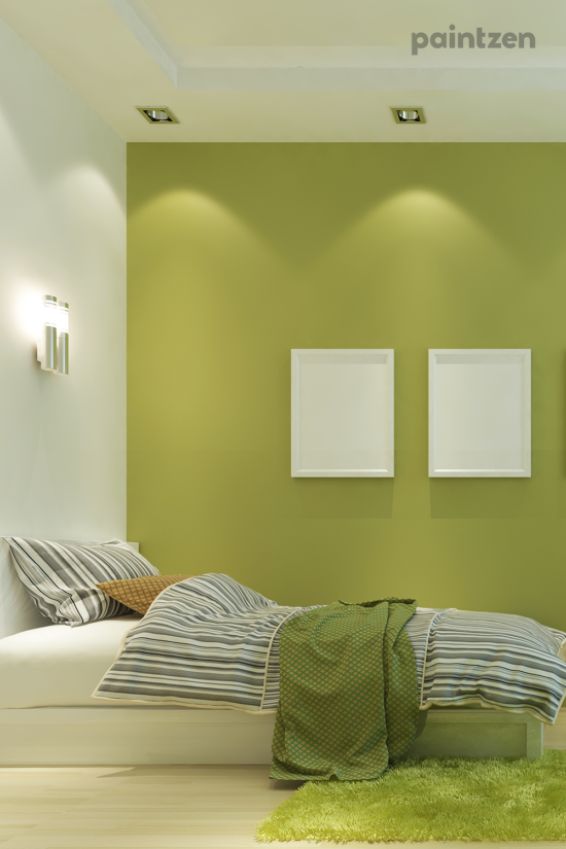background knowledge will quickly be taught better. How to paint a room
Painting a room is easy. However, a space is made up of many segments—each with specific painting challenges. How to paint a room The inner wall with the door requires meticulous handling of the frame when painting.
You should pay particular attention to this in rental apartments. Frames or strips sprayed, painted, or smeared with emulsion paint are severe defects that can endanger the entire deposit!
Widen the room: paint the ceiling and side walls light blue. This also makes the room “cooler.” If you want to avoid this, a dark floor has the same effect on white / light walls and ceilings.
Reduce space: paint the ceilings and side walls in reddish-brown. This also makes the room appear “warmer.” Alternatively, you can paint the walls with diagonal stripes. This also makes the room visually more restless.
Decrease room height: The room looks lower when the ceiling is dark. Another trick is to continue the ceiling color as a 20-30cm strip on the sidewalls.
Emphasize the height of the room: Darker sidewalls than the ceiling increase the space. The effect enhances when the wall paint transfers to the ceiling as a wide strip. Another way is to paint the side walls with vertical stripes.
Shorten the room: If the visible wall paints a darker color as seen from the door. The room appears shorter.
Extend the room: With the reverse contrast. The room extends.
Table of Contents
Paint a room
Important: Sockets are carefully masked with crepe and plastic sheeting. They must not soil with paint when painting. This can disable the protective contact, which can damage connected electrical devices.
To test a painted wall, first, rub it dry with the palm of your hand. If the paint has not peeled off, stick a piece of masking tape to the wall and tear it off again. If no color has peeled off during the brushing test and later during the tear test, you can save yourself priming. Otherwise, it must prime.
In the case of plastered walls, you rub the wall with the palm of your hand and check whether the sand is peeling off. Then you spray the wall with some clear water. If it immediately goes deep. The fence must also be prime.
Drywall made of plasterboard is generally primed.
If you save yourself the primer, the fresh paint will not be able to adhere properly. It then peels off, which in the end can only straighten out again by new wallpapering.
Clean wall
Suppose the old paint is easily removable. It must remove. This is a significant challenge, especially with wallpapered walls as the wallpaper must never remove with it. A rough sponge and warm water are used to wash off old paint. You have to proc quickly. The water should only dampen the stain. Not the wallpaper. With large. Circular movements. You can also use a scrubber instead of a rough sponge. Then the dissolved dye was off again with a soft sponge. Then let the wall dry.
Prime walls
To prime the wall, you need:
- Deep ground
- Tassel
- Water bucket
Tiefgrund offers ready-to-use or as a concentrate. Ready-mixed primer costs around 8-10 for the 5-liter container. Concentrate to mix yourself costs around 5-8 per liter. A good tassel is available for approximately 6.
Prime plasterboard
You can see the deep primer applied too thickly in the shiny areas after drying. Here something has to remove from the deep ground with a rough sponge.
Corner to the surface, ceiling to wall
To paint the room you need:
- High-quality wall paint in the desired shade (approx. 5-8 per liter)
- Brush (10 in a set of 4)
- Small roll (5
- Big roll (8
- Pull-off grid (1)
- Color bowl (1 )
- Head (100 )
You always paint a room from the corner to the surface and from the ceiling to the wall. First, all masked areas dab off with a brush. The dabbing prevents the paint from seeping under the tape. Then the corners are pre-painted with the meeting.
When painting with the roller. It is never wholly immersed in the paint. Only submerge until the fleece moisten. Then the roller turns a little further and wets again. This repeats until the entire roll is damp with color but not soaked.
Paint ceilings
When painting the ceiling, use a brush to paint squares of approx. One m². It is sufficient to paint quickly, roughly, and thinly, as these squares are only for orientation. The ceiling is now painted in squares. First lengthways, then crossways. The courts must overlap when painting, and that painting is always wet-on-wet.
paint a room
After the surface has been painted, it is left to dry for at least 2 hours. Turning on the medium heat heater can help to shorten the drying time. The safer way, however, is to paint over the area again in the cloister.
paint walls
Walls painted in stripes approx. 1 meter wide. The extensive roll guide from top to bottom. That’s why you have to work a little quickly here. The next lane applies with an overlap. When the wall finishes, let it dry again and check if the wall needs to paint a second time. Start over with That’suing points.
A tip on this: If the adhesive tape was used to create color accents, it is best to remove it while the color is still damp. This is how you get the cleanest transitions.
In the case of window walls. The frames paint with a small roller. Careful work is constructive here. Dried paint on windows, window sills, structures, and radiators is challenging to remove.
It is precisely this detail that can significantly improve the overall impression. This also includes washing the radiator. Window frames, baseboards, switches, and sockets thoroughly before reassembling.
Also read: How to get rid of dark spots on face



















